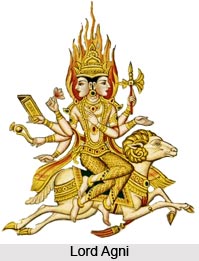 There are thirty one hymns in Book V of Atharva Veda. The first hymn glorifies Trita and Varuna. The following hymn is again the glorification of Lord Indra. The third hymn is a prayer to Lord Agni, Lord Indra and other deities for victory and prosperity. The succeeding hymn is regarding charm against fever and other illness. The fifth hymn is a charm that would repair a broken bone. Prayer for safety and prosperity constitutes the sixth hymn. The seventh hymn condemns Arati or Malignity. Humiliation and destruction of aggressive priests makes the eighth hymn. Ninth hymn is a prayer to Heaven and Earth for protection and assistance. The tenth hymn is dedicated to the presiding deities of the four quarters for security.
There are thirty one hymns in Book V of Atharva Veda. The first hymn glorifies Trita and Varuna. The following hymn is again the glorification of Lord Indra. The third hymn is a prayer to Lord Agni, Lord Indra and other deities for victory and prosperity. The succeeding hymn is regarding charm against fever and other illness. The fifth hymn is a charm that would repair a broken bone. Prayer for safety and prosperity constitutes the sixth hymn. The seventh hymn condemns Arati or Malignity. Humiliation and destruction of aggressive priests makes the eighth hymn. Ninth hymn is a prayer to Heaven and Earth for protection and assistance. The tenth hymn is dedicated to the presiding deities of the four quarters for security.
The eleventh one is basically a dialogue between Varuna and Atharvan. Next hymn is regarding propitiatory sacrifice. The thirteenth one is a charm against snakes and the fourteenth is that against witchcraft. Fifteenth hymn is for prosperity in general. The following hymn is for cattle increase. Seventeenth hymn is regarding to the abduction and restoration of a Brahman`s wife. Both the succeeding hymns is wickedness of oppressing and robbing Brahmans. Twentieth hymn is a prayer to war drum in order to win the battle.
Twenty first hymn is also invocation to War drum as well as other deities in order to secure victory in the war. Next is the charm against fever. Twenty third hymn is charm against parasitic worms. Following hymn is a prayer for assistance and protection. Safe conception makes up the twenty fifth hymn. The next one is an invitation to the Gods. Twenty seventh is a propitiatory hymn. The succeeding one would ensure wealth and safety in general. Twenty ninth one is charm against destruction of wicked goblins. Lat but one hymn is to restore health and life. The last or the thirty first hymn is a counter charm against the prayers of an enemy.
This article is a stub. You can enrich by adding more information to it. Send your Write Up to content@indianetzone.com



















